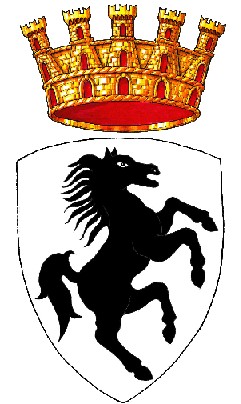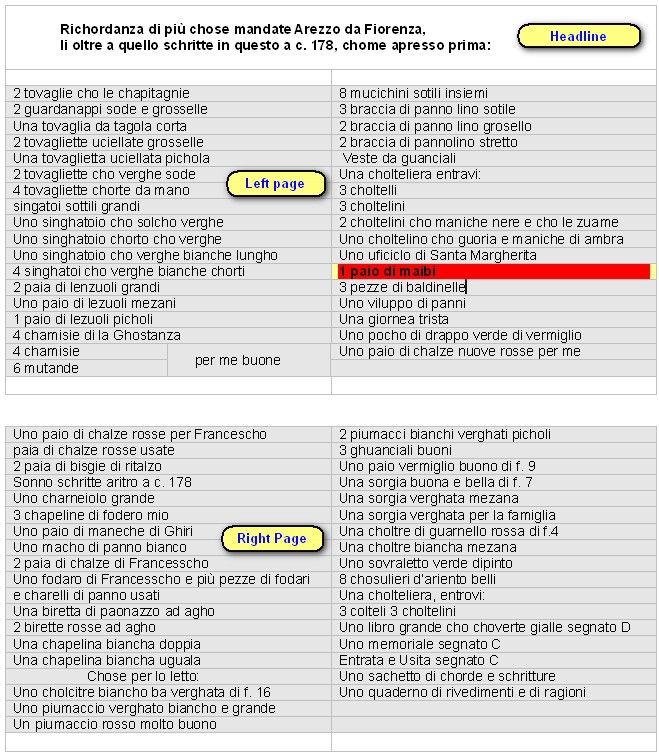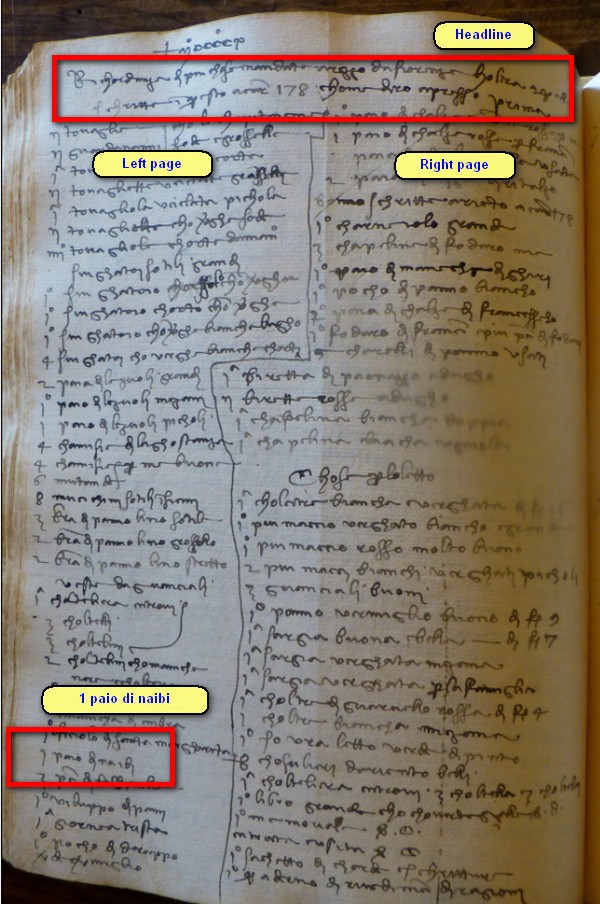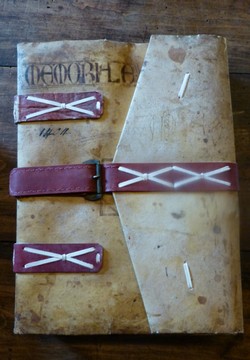Introduction
This new information comes again from the same Fraternita dei Laici of a previous note;(1) this allows me to reduce this introduction to a minimum. In a book dealing with the trade of retailers in Prato in the end of the 14th century,(2) the author lists suitable archives in Europe: surprisingly enough, he indicates for Italy just a few collections in Florence and Prato; even less archives he mentions abroad. Actually, he gives a hint to Fraternita dei Laici in Arezzo too, (without having visited it) on the basis of a comment by Federigo Melis (1914-1973),(3) who was studying the many account books kept there. Unfortunately, Melis came to an untimely end without publishing his research, and only a few dissertations have been kept about these account books, mostly carried out under his guide.
I have examined one of the account books of Lazzaro Bracci (c1365-1425), “Libro rosso segnato C”(4) that had been studied and transcribed in one of these dissertations.(5) In this case, the author of the dissertation work was destined later on to become a known university professor, continuing Melis’ pioneering historical approach.
Lazzaro Bracci - a great merchant from Arezzo
The problem that I have with Lazzaro Bracci, the merchant involved here, is not of finding some information on his life, as it occurs in other cases. Here, we have more information available than strictly required for illustrating the context in which a Naibi pack is found. The risk is to deal with Lazzaro more than required for introducing the result of this study in its context: after all, I am just discussing a single pack of Naibi - once more, this had already occurred in a couple of cases.
Lazzaro Bracci, together with other merchants from Arezzo, assisted the progress of this town as an important centre of trade of the local products (as well as of those from the near regions of Umbria and Marche, which did not have a strong basis for the sea traffic), towards Florence, Pisa, and the many sea-towns reachable from there; a capillary distribution of goods arriving from Florence and the Tyrrhenian Sea occurred at the same time in the contrary direction.
First of all, let me refer to a publication about Lazzaro Bracci by Federigo Melis himself;(6) it was transcribed from a verbal communication, and thus has the benefit of an easy and colloquial style. A more succinct description - with nevertheless more detailed information - one finds at his name in “Dizionario Biografico degli Italiani”.(7)
About the successful commercial activity of Lazzaro Bracci we first find information in Pisa in 1390 where he led a branch of a company established in his home town Arezzo. From Pisa he found new channels for trading goods produced in Arezzo and adjacent regions, after voyages to Genoa, Sicily, and even Constantinople. A few years later, he changed his position into co-partner of the company, and opened in Pisa a manufacture of woollen clothes; at the same time, he began a parallel financial and insurance activity.
In 1398 he moved to Florence, where he remained for about ten years. The dimension of his trades decreased, but at the time he set up in business for himself, developing the financial and insurance aspects in substitution of the manufacturing activity established in Pisa. A production of woollen clothes he again resumed in his home town Arezzo, where he moved first in 1410 (alternating however his stay there with intervals spent in Florence for his financial activity) and in a definitive way in 1415.
He died in 1425 and left his huge properties precisely to Fraternita dei Laici for its charitable activities, and for cycles of Masses for promoting his own soul in the years to come. Included in his inheritance, and now available in the ASFdL, were no less than eighteen of his account books, which provide a unique documentation on trades involving Arezzo and Pisa, in addition to Florence.
One particular shipment from Florence to Arezzo
I leafed through one of Lazzaro’s books(4) and, when I was convincing myself that it did not contain anything of our interest, I pinpointed a line with a pack of Naibi on fol. 182r; this article is the most interesting that I could find here, because 1410 is granted as too early for either Trionfi or Minchiate. I am not sure that this is the only occurrence of our items in this account book, but I was satisfied with this entry, at least for the moment.
This particular pack of Naibi is not present as an item traded. Of course, finding just one pack of playing cards among big transactions would have been rather unlikely. As a matter of fact, this is a pack included in a shipment of many personal objects, which Lazzaro sent from Florence to Arezzo in November 1410, apparently when he was moving there, together with his family.
The transcription of this account book by Bruno Dini is part of his dissertation, one of those guided by Federigo Melis about Lazzaro Bracci.(5) Obviously, I wanted to check the presence of this Naibi pack in the typewritten transcription and any possible discussion about it. A copy of this dissertation is kept in the ASFdL, and I could check the transcription of all the records of the goods sent from Florence to Arezzo.
I had never seen a similar dissertation. The dimension of the volume with the transcription to verify are 25x34 cm for a thickness of 9 cm. It is thus much thicker than usual, but this is not all: there are no less than three such volumes for this one dissertation. It is true that the typescript has wide margins and double or triple spacing of the lines, but it looks more similar to an encyclopaedia than to any dissertation of the many ones that I had in my hands. It is also true, on the other hand, that the original handwritten book is not a thin volume on its turn.
From the dissertation
The transcription by Dini of the page under examination is reproduced below. It corresponds to the final part of the long list involved, after some trades recorded in-between.
There are several words that are written here in a questionable way, but I prefer to leave the choice of their spelling to this specialist, more familiar than I with the matter, and with the personal handwriting of Lazzaro.
|
|

Arezzo had been a proud city in 13th century, with one of the oldest universities (1215). Emperors visited the city, as it had a Ghibelline orientation, so Henry VII in September 1312. It competed with Florence in 14th century, but was taken in 1384. The inhabitants of the region had a rebellious spirit, which played a role in the story of
the battle of Anghiari (1440).

Petrarch was born in Arezzo.
|
|
|
There is however one word, which I cannot absolutely leave as such, without discussing and amending, “maibi”, as he transcribed the record of our card pack.
Maibi
It is certain that in the dissertation we clearly read “maibi” instead of “naibi”, as I had read in the manuscript [compare Appendix]. Now, we know that Naibi is here a very unfamiliar name for anybody, who does not know the early history of playing cards well enough. On the other hand, the accompanying term of “Uno paio” does not provide any hint to a pack of cards - again, if one does not know the early history of playing cards.
What I intend to point out is not that these researchers must be blamed because they made such mistakes; this is something that is hard to avoid, and we are familiar with this trouble. The question is that, merely owing to this problem, we may have lost notice of a lot of ancient documents, with significant information on the early history of playing cards.
In this particular case, how could an indication of playing cards be discovered, if they were called “maibi”? I had already seen several different ways, in which Naibi was written, Narbi included, but never before had seen this one. It may thus be a useful indication for experts used at present to carry out their investigations with the web searching tools: maybe useful documents may now come out just by inputting this new word in their searches. As for me, I only met Indian priestesses in a first trial.
Utilisation
In the list of the goods shipped, we find many personal objects, from stockings, to shirts, to pants. These are all items for Lazzaro’s own use or, when indicated, for some of his family members. Other entries correspond to table and bed linen, and other household articles. It is evident that this pack of Naibi was a common object, to keep available for playing, whenever a suitable circumstance occurred.
At first sight, we do not find anything surprising with this pack of Naibi: it is something that reminds us of our own habits of nowadays; this analogy probably represents, however, the main merit of this finding.
It is indeed necessary to pay some attention to the situation of the time, because we know very little of playing cards and card games of the beginning; moreover, what we know derives from scattered information, which involves really contrasting aspects. Sometimes we read that Naibi were a safe and innocent tool, to be used by children for assisting their education; more often, on the other hand, we find players of Naibi severely punished, as if they had perpetrated atrocious crimes.
I have the impression (only that, but it is already lasting for many years) that the actual situation was much more “up-to-date” than we can deduce from the laws of the Communes, and even farther from the comments of the preachers. There is a rather similar case with the women’s dressing at the time: we know from several documents, pictures included, that they did not comply at all with the severe laws that aimed to limit their magnificence.
If we reflect on this topic, the sole Naibi pack encountered here acquires a lot of additional value as a new document. Maybe, there existed by then children using Naibi for their education; certainly, gamblers were present, and cardsharpers as well, who used Naibi for their dishonest acts. The pack of Naibi discussed here clearly confirms a different situation, a game tool that one could enjoy in playing with, and that could be packed together with linen and underclothes, adjacent to a religious booklet.
Conclusion
I have followed the path traced by the pioneering work of Federigo Melis about Lazzaro Bracci, a merchant active in subsequent times in Pisa, Florence, and Arezzo. For the moment, I could detect only one record of interest here: a Naibi pack in a shipment of November 1410 from Florence to Arezzo of various personal articles sent by Lazzaro Bracci, and recorded by him in the account book examined.
This small piece of evidence is just another initial fruit of my research in this archive; I hope to find further documents, and more Naibi packs. The pack discussed here is however particularly interesting, because we find it in a context, which beyond question belongs to a family environment.
Footnotes:
(1) 1400 – Naibi on Loan in Arezzo
(2) Richard K. Marshall, The local merchants of Prato. Baltimore 1999.
(3) Federigo Melis - A brief biografy
(4) ASFdL, 3337, Compagnia di Firenze, “Memoriale C”: 1404-1423.
(5) B. Dini, L’attività del mercante aretino Lazzaro di Giovanni di Feo Bracci nella parte finale del periodo fiorentino, Voll. 3, Univ. di Pisa, Tesi di laurea, 1963.
(6) Federigo Melis (a cura di Bruno Dini), Industria e commercio nella Toscana medievale. Firenze 1989, pp. 175-191.
(7) Treccani.it: Lazzaro Bracci ; Vol. 13 (1971).
|
|





